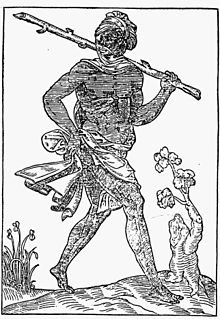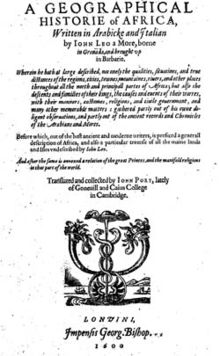Leo Africanus
Leo Africanus , maiden name: Arabic الحسن بن محمد الوزان الفاسي, DMG al-Ḥasan b. Muḥammad al-Wazzān al-Fāsī , Christian baptized in the Latin name Johannes Leo, Italian Giovanni Leone (* around 1490 in Granada ; † unknown, possibly after 1540 in Tunis ) was a diplomat , legal scholar, translator and author of travel and geographic reports about North Africa of Berber descent.

Life

Leo Africanus was born in Granada around 1490, but his family soon moved to Fez after his birth , forced by the Reconquista . There he studied at Qarawiyin University and accompanied his uncle on his diplomatic travels in North Africa, visiting Timbuktu , Gao , Agades and Cairo as well as numerous nomadic tribes and Berber dynasties.
Residence in Italy: 1518 to around 1530
Leo Africanus was captured at sea in 1518 by Pedro de Cabrera y Bobadilla , a Christian corsair of distinguished origin, and brought to Rome . He then lived in Rome locked up in Castel Sant'Angelo under the care of Pope Leo X until he converted to Christianity . He was then released and began working as a scholar and translator in Arabic literature; Among other things, he worked on the Latin translation of the Koran, learned the Italian and Latin languages and wrote the description of Africa and other works in Italian .
Last years in North Africa: around 1530 to around 1537
Possibly Leo returned to Tunis around 1530 and turned back to Islam . This date is based on speculation and has to do with the appearance of the first printed version of his travel book this year. The German orientalist Dietrich Rauchberger assumes that Leo left Rome around 1530, because after that there are no more indications of his presence in Italy. The scholar may have died on Italian soil from one of the epidemics that broke out in the wake of the wars raging on the peninsula. In any case, in North Africa there are no more documents to prove his presence in Tunis or one of the other cities on the North African Mediterranean coast. However, some authors suggest that Leo spent the last years of his life in Fez, where he died in 1537. A return to Fez or to the Islamic world in general would have been very difficult, however, as Africanus converted and his Christian editors revised his books in an anti-Islamic manner before they published them, Leo Africanus possibly married a Christian in Rome and perhaps had children with her, as well helped translate the Koran into Latin .
Nathalie Zemon Davis is convinced that she found an entry for an apartment in Rome in January 1527 in the name of Johannes Leo ; in their opinion it should be Leo Africanus. For the time after the Sacco di Roma it is not known whether Leo Africanus continued to live in Rome. He may have returned to the Maghreb . A testimony from his godmother and patron Egidio da Viterbo to Johann Albrecht Widmannstetter from 1532 suggests that Leo Africanus was living in Tunis at the time. Widmannstetter, who wanted to learn Arabic, then tried to visit Leo, but was prevented from storms in the Mediterranean.
plant
He traveled from Morocco to the Sahara and Sudan and published his findings in his work La descrittione dell'Africa ( German : " The Description of Africa "), which for centuries was a very influential work on the geography and culture of North Africa in Europe . Above all, the work depicts the wealth and splendor of the Songhai Empire and describes the prosperity of the caravan metropolis Timbuktu and the clay mosques there , so that it sparked the fantasies of Europeans until the early 19th century. Two and a half centuries after its first publication motivated the 'Description of Africa' the interest of exporting to Africa States and thus indirectly put scientific research on Africa (since 1790) in motion. The work became obsolete as a geographic source through explorations by European explorers such as Mungo Park , René Caillié and Heinrich Barth . Barth, who himself had personally visited large parts of the countries described by Leo Africanus, was supposed to publish an annotated translation for the renowned Hakluyt Society , but was prevented from completing it by his sudden death in 1865. The editions, which were published on behalf of the Hakluyt Society at the end of the 19th century and by French scientists in the middle of the 20th century, were based on the printed editions of the 16th century, which, however , have been heavily revised by the editor Ramusio compared to the handwritten original were. Many of the myths of Timbuktu's immeasurable wealth can be traced back to the incorrect translation by the Italian editor, as Dietrich Rauchberger discovered when studying the original manuscripts.
reception
Leo became relatively known as a person through the novel, '' Leo Africanus, which has been translated into many languages . The Pope 's Slave '' by Lebanese Amin Maalouf . Another work that is dedicated to his life is Leo Africanus: A Traveler Between Orient and Occident by Natalie Zemon Davis . There are theories that question the existence of Leo Africanus and claim, among other things, that the work was written by a Venetian ghostwriter , since Venetian merchants have been trading with North Africa since the 12th century and must have collected a lot of information in this way . However, this is contradicted by detailed autobiographical comments in the Descrittione dell'Africa as well as numerous signatures and comments that Africanus had written in the writings of the Vatican library .
Work editions
- La descrittione dell'Africa . In: Giovan Battista Ramusio (ed.): Primo volume, et Seconda editione delle Navigationi et Viaggi. Venice 1550.
- Historiale description de l'Afrique, tierce partie du monde, contenant ses royaumes, regions, viles, cités, peuples, escrite de nôtre tems par Jean Leon, Africain, premièrement en langue arabesque, puis en toscane, & à présent mise en françois. Lyon 1556. (A French travel collection by Jean Temporal with other authors such as Amerigo Vespucci)
- Georg Wilhelm Lorsbach (Hrsg.): Johann Leo's des Africaners description of Africa. Herborn 1805. (First German-language edition of the work)
- Robert Brown (Ed.): The history and description of Africa and of the notable things therein contained, Written by Al-Hassan ibn-Mohammed Al-Wegaz Al-Fazi, a moor, bapticed as Giovanne Leone, but better known as Leo Africanus . Done into English in the year 1600 by John Pory . The Hakluyt Society, London 1896, 3 volumes. (For a long time the authoritative scientific edition)
- Alexis Épaulard, Henri Lhote , Théodore Monod (eds.): Description de l'Afrique. Paris 1958, 2 volumes.
- Karl Schubarth-Engelschall (Ed.): Description of Africa. Leipzig 1984. (Incomplete popular edition, but published by one of the best experts on Islamic Africa research)
- Dietrich Zigarrenberger (Ed.): Johannes Leo the African. His description of the space between the Nile and Niger according to the original text. (Orientalia biblica et christiana, 13). Wiesbaden 1999, ISBN 3-447-04172-2 .)
literature
- Alioune Benachenhou: Hassan ben Mohamed el Ouzzane, dit "Leon l'Africain". L'Algerie en 1515. Algiers 1969.
-
Natalie Zemon Davis : Trickster travels: A sixteenth-century Muslim between worlds. New York 2006, ISBN 0-8090-9434-7 .
- German: Leo Africanus. A traveler between the Orient and the Occident . Translated from the English by Gennaro Ghiradelli, Wagenbach Verlag, Berlin 2008, ISBN 978-3-8031-3627-5 .
- Pekka Masonen: The Negroland Revisited. The Finnish Academy of Science and Letters, Helsinki 2000, ISBN 951-41-0886-8 .
- Dietrich Zigarrenberger (Ed.): Johannes Leo the African. His description of the space between the Nile and Niger according to the original text. (Orientalia biblica et christiana, 13). Wiesbaden 1999, ISBN 3-447-04172-2 .
- Oumelbanine Zhiri: L'Afrique au miroir de l'Europe: Fortunes de Jean Léon l'Africain à la Renaissance. (Travaux d'Humanisme et Renaissance, 247). Libr. Droz, Geneva 1991, OCLC 28291357 .
Fiction
- Amin Maalouf : Leo Africanus. The Pope's slave . Munich 1988 a. ö, ISBN 3-485-08220-1 .
Web links
Individual evidence
- ^ Dietrich Rauchberger: Johannes Leo der Afrikaner. His description of the space between the Nile and Niger according to the original text . Harrassowitz Verlag, 1999, pp. 27-28.
- ^ Davis, Nathalie Zemon: Leo Africanus; A traveler between the Orient and the Occident. Wagenbach, Berlin 2008, ISBN 978-3-8031-3627-5 , p. 19. - 30 .
- ^ Davis, Nathalie Zemon: Leo Africanus; A traveler between the Orient and the Occident. Wagenbach, Berlin 2008, ISBN 978-3-8031-3627-5 , p. 33. - 40 .
- ^ Davis, Nathalie Zemon: Leo Africanus; A traveler between the Orient and the Occident . Wagenbach, Berlin 2008, ISBN 978-3-8031-3627-5 , p. 57. - 63 .
- ^ Masonen, Pekka: The Negroland Revisited . The Finnish Academy of Science and Letters, Helsinki 2000, ISBN 951-41-0886-8 , pp. 174. - 175 .
- ^ Davis, Natalie Zemon: Leo Africanus: a traveler between Orient and Occident. Wagenbach, Berlin 2008, ISBN 978-3-8031-3627-5 , p. 247-263 .
- ^ Davis, Nathalie Zemon: Leo Africanus; A traveler between the Orient and the Occident . Wagenbach, Berlin 2008, ISBN 978-3-8031-3627-5 , p. 213 .
- ^ Davis, Natalie Zemon: Leo Africanus: a traveler between Orient and Occident. Wagenbach, Berlin 2008, ISBN 978-3-8031-3627-5 , p. 252 .
| personal data | |
|---|---|
| SURNAME | Leo Africanus |
| ALTERNATIVE NAMES | Al-Hasan ibn Mohammed al-Wassan (real name) |
| BRIEF DESCRIPTION | Arab traveler and geographer |
| DATE OF BIRTH | around 1490 |
| PLACE OF BIRTH | Granada |
| DATE OF DEATH | after 1550 |
| Place of death | Tunis |


